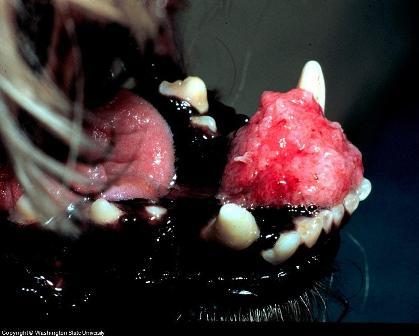Cancer: Categories
Overview:
Cancer in general refers to progressive, uncontrolled and proliferating cellular division. In dogs, it may occur in any system, any organ or any tissue whose cells have a tendency to divide. Cancers are usually benign or malignant i.e. are capsulated/contained in an areas or are diffused/spread out respectively. Cancers may also be primary or secondary i.e. cancerous cell development in an organ & then transmitted to other parts of the body. Primary refers to where the cancer originated, secondary refers to cancers that were spread from another part of the body. In a more specific way, a cancer can be a carcinoma or may be sarcoma i.e. of epithelial (outer layer of the skin) tissues or of connective tissues respectively.

Sign of Canine Cancer
Akita pup with a
fibrosarcoma (maignant tumor)
Source: Washington State University
In dogs, the cancers can be of various types, caused by various agents and factors, and may have a unique pathogenesis (how a disease develops), treatment plan & respective prognosis.
Types:
Cancer can develop in any part of body, any system and any tissue. The nomenclature for different cancers in general is referred to by the tissues they affect. Carcinomas e.g. describe cancer of epithelial (outer skin layer) tissues of any kind, which may proliferate and diffuse to adjacent tissues. Sarcomas on the other hand refer to cancer of connective, blood or lymphatic tissues which may or may not spread to other tissues.
Cancers may be primary or secondary. Primary cancer affects certain organ, and then spreads to adjacent tissues in secondary or latter stages. For example, canine cancer of thyroid gland tissues can affect adjacent tissues of the respiratory system too, which in general is called “metastasis”.
Also dog tumors may be benign (not life threatening and treatable) or malignant (fast growing, threatening), capsulated (enclosed or contained area) or diffused (spreading deeper into the diseased tissue) respectively. Specifically the term “cancer” is used for malignant type of tumors.

Dog Mouth Tumor
Source: Washtington State University
On basis of such classification, canine cancers are described with terms such as bladder tumors, mast cells tumor, mammary carcinoma, squamous cell carcinoma, oral cancers, hemangiosarcomas, testicular cancers, osteosarcomas, melanomas etc.
Causes:
There are different agents and factors which may cause canine cancers. In recent years, reported cases of canine cancers have significantly increased due to exposure to many environmental carcinogens and awareness amongst dog owners.
Genetic mutation in cells is supposed to be primary cause of dog cancers. Genes that control the cellular growth when damaged or suppressed may cause cancer. Mammary carcinomas and some kinds of melanomas are examples of such cancers in dogs.
Many non mutating agents like hormonal disturbance can also help to cause a cellular division disturbance, which can trigger a cancerous cell division. Excessive release of estrogen is one example, which can initiate an uncontrolled cell division in the testes.
Oncogenic viruses, like types of herpes viridae and retro viruses may cause cancer in dogs. Hepatitis B virus can cause a liver cancer in dogs. Similarly a lymphoma is surely caused by EBV – a type of virus included in herpes viruses.
Environmental factors are also responsible in causing cancer and canine cancer symptoms. Squamous Cell Sarcoma is more common in dogs that live in urban areas; it is suspected that it is due to pollutants.
Diagnosis:
Different techniques have been applied to diagnose cancer in dogs. Signs and visible canine cancer symptoms in most cases are non specific and usually are confusing if being used as a means to differentiate between different illnesses. Most canine cancers are diagnosed while screening dogs for other reasons.
Radiographic imaging is one of the most effective ways to diagnose canine cancers, but in most cases, cancers involving metastasis can not be confirmed via radiography.
Biopsy and exploratory surgery are the most reliable and effective techniques for diagnosing dog cancer. These techniques not only reveal the severity and the cause, but also the prognosis for certain dog cancers, which is important for a dog owner to be told prior to any further procedures take place. The primary objective is to maintain a dog's quality of life, so understanding the canine cancer prognosis and the implications of treatment is helpful in reaching an informed treatment decision.
Treating:
Surgery has remained a primary choice for eliminating any cancerous mass. Radiation therapy and chemotherapy is effective, but not for the complete eradication of cancers when used alone.
Surgery, radiation therapy and chemotherapy in combination leads to a more positive result, but can’t be applied in most cases due to severe adverse effects and chances of secondary complications.
Homeopathic or alternative approaches are not a cure, but could provide additional support. One product for additional research that is made specifically for this purpose is C-Caps Formula for the prevention and treatment of cancer in dogs. In contains ingredients such as Astragalus membranaceous (immune system support), Viscum album (immune system, blood pressure) and Echinacea purpurea (immune system).
|
|